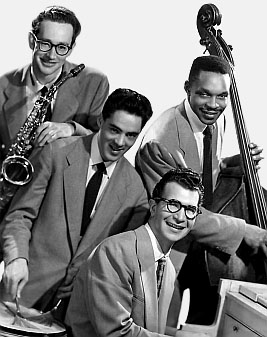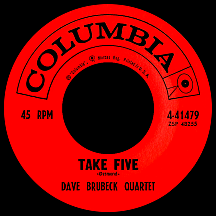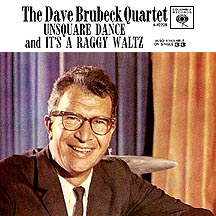DAVE BRUBECK QUARTET
Take Five
Musically speaking, timing was everything to Dave Brubeck. Born in 1920 in Concord, California, he possessed a natural rhythm. During his teenage years he was a ranch hand, working for his father, Pete Brubeck, in the San Joaquin Valley. To fend off boredom he would make up melodies, using the rhythm of the ranch (galloping horses, the sounds of machinery and so on) as inspiration. His mother, Bessie Brubeck, a former concert pianist, gave him piano lessons when he was a youngster. As a result of some early eyesight problems, Dave never learned to properly read music, admitting to often "faking it."
Dave liked to alter the rhythms of songs when he played piano, sometimes catching the ire of musical purists. But a career in music seemed unlikely as he struggled through music courses, as a result of his vision, at the College of the Pacific in Stockton. He married another student, Iola Whitlock, while on leave shortly after he'd joined the Army in 1942. They eventually had six children. After his discharge in the mid-'40s, he attended Mills College in Oakland and studied under French composer and teacher Darius Milhaud. Opportunities arose for him to sit in as pianist with a few San Francisco area jazz bands; one was called The Three D's and sometimes featured alto saxophonist Paul Desmond, who'd been playing clubs around the area. At school, Dave became part of a cavalier bunch of student experimenters who called themselves "The 8." Like him, they were interested in stretching the rhythmic and harmonic boundaries of music, if for no other reason than to see where it might lead. Eventually they became known as The Dave Brubeck Octet.
In 1950, the Octet included Desmond and Brubeck, clarinetist and baritone saxophonist Bill Smith, tenor saxophonist David van Kriedt, trumpeter Dick Collins, trombonist Bob Collins, bassist Jack Weeks and a drummer that would one day be a major jazz star specializing in Latin percussion, Callen "Cal" Tjader. They rehearsed often, applying classical structure to the modern jazz style. The band's public performances numbered just four: two 1946 concerts at Mills College, a gig opening for Woody Herman in San Francisco the following year and one final appearance in '48 at Dave's former college, the COP in Stockton (a number of recordings were made on acetate and were released in various forms a few years later). Out of this experience grew the Dave Brubeck Trio, with drummer Tjader and bassist Ron Crotty.
The trio made its recording debut in 1949 with a 78 RPM on the Coronet label, "Laura" backed with "Indiana." These and two other tracks (second single "Blue Moon" and "Tea For Two") were recorded in just a half hour, demonstrating the sort of excellence one might expect to hear at a live show, Dave's uniquely energetic piano work (particularly on the latter two selections) the selling point for jazz aficionados. Then the Brubeck Trio landed with a new label, Fantasy, named after The Magazine of Fantasy and Science Fiction, which had begun in 1949 (at first they used the Fantasy mag's logo on record labels; later, the company added Galaxy Records, named after another popular sci-fi magazine of the era). Several records were issued that year, most of them reconfigured versions of standards ("Singin' in the Rain," "Body and Soul"), before the trio broke up. Cal Tjader joined George Shearing's outfit on his way to making a name for himself. Desmond and Brubeck started the Dave Brubeck Quartet, which would undergo a few changes in the bass and drum spots before the permanent band set themselves up to famously make history.
Leaving Fantasy in 1954, the quartet signed with Columbia Records and albums like Jazz Goes to College and Dave Brubeck at Storyville: 1954 sold above the levels of earlier efforts. Dave found himself on the cover of Time magazine the week of November 8, 1954, the second jazz artist to make the publication's cover (Louis Armstrong had been first, in 1949). It was a distinction that puzzled him, as he felt Duke Ellington deserved the distinction (Duke finally got his due in August 1956). A prolific quartet of five (Crotty and Bob Bates alternated bass duties), Dave's band regularly put out three or four albums each year. Drummer Joe Dodge contributed to these and Brubeck Time, a top seller in 1955. The classic lineup came together in 1958 with Dave and Paul, bassist Eugene Wright (who'd led his own band, The Dukes of Swing) and drummer Joe Morello (a former violinist who performed with The Boston Symphony Orchestra during his childhood). In 1959, Dave and his family moved from their home in Oakland to Connecticut (it turned out to be permanent) while Paul departed S.F. for a top-floor apartment in Manhattan that he never moved out of. The two, it seemed, were essential to each other's success.
The album Time Out, made up of seven songs performed in as many different time signatures, catapulted the DBQ into mainstream, way-beyond-jazz-circles stardom, though not right away. It didn't even hit the album charts until a year after release. While touring in Istanbul, Turkey, Dave heard a street band playing a song in 9/8 rhythm and later composed "Blue Rondo a La Turk" based on the strange sounds he'd heard; initially this was the album's standout track. "Kathy's Waltz," which mixed contrasting time signatures, was written by Dave for his daughter Cathy, but the title was misspelled with a "K"...and so it remained. "Take Five" was written by Desmond in 5/4 time, combining two separate melodies that Dave felt would work together, one as the verse and the other as a bridge. Morello was given as many bars as he needed to do a drum solo and it became the focal point of the piece, which ran nearly five and a half minutes.
While Time Out simmered on the front burner, the quartet continued making albums, all of them well-received, as the band embraced its higher profile in the music world, performing and recording with a number of top stars (Armstrong under the banner of The Real Ambassadors, The New York Philharmonic with conductor Leonard Bernstein, Jimmy Rushing, Carmen McRae and, in London, bassist Charles Mingus). Suddenly (or so it seemed), the "Take Five" 45 became an unexpected top 40 hit in September 1961. Billboard magazine gave credit to Chicago juke box operators for keeping the single in machines well beyond its release and also to WNEW in New York for giving "Take Five" heavy spins, even though it had been out (and presumed over) for some time; Columbia took notice, reserviced the single, and it started to take off. Stations in Dave's former San Francisco stomping grounds quickly picked up on what was happening; soon it spread across America and into several foreign countries.

The two minute and 50 second edit excised most of Morello's drum solo and the song became a hit based on that version, leaving a different impression with the mainstream audience than it had made with the jazz fans who discovered the track the first time around. George Cates rushed out an even shorter version for the Dot label that simply couldn't compete. Time Out had a spectacular rebound in sales, reaching number two on the album chart (behind Judy Garland's Judy at Carnegie Hall) in November. A live version featuring Carmen McRae (the single and sheet music crediting Iola Brubeck as lyricist) was icing on the cake. An identically-conceived LP, Time Further Out, appeared just after "Take Five" became such a big hit, appearing to be a follow-up album, though it was actually recorded more than two years and some ten LPs after its similarly-named parent. More unusual tempos were experimented with and the album went top ten.
"Unsquare Dance" was done in 7/4 time, a structure that made it difficult to bring the thing to an end. Dave figured it out (the tempo is abandoned in the last few seconds) and Desmond can be heard chuckling at the end, relieved that it 's over. It was decided then and there they would never perform it live; Columbia released the Time Further Out tune after "Take Five," but the band purposely refrained from doing it. Brubeck began featuring "Unsquare Dance" in concert during the '70s and its popularity has risen steadily ever since. With the purist naysayers decidedly outnumbered, Brubeck and his men continued indulging in their predilection for unconventional time signatures as a new Columbia album hit stores on average every four months and concert appearances were booked at a steady clip, sometimes teaming them with stars like Tony Bennett.
After hearing Stan Getz and Charlie Byrd doing their "Desafinado" bossa nova in 1962, the Brubeck Quartet came up with their 3/2 "Bossa Nova U.S.A.," drummer Morello putting his own accent on it. Rejoining Louis Armstrong in 1964 for some creative studio fun, they backed him on their last charting single, the exotic "Nomad," in 1964. Dave, Paul, Eugene and Joe remained together until 1967. Dave worked with many different musicians in the ensuing years including his sons, keyboard player Darius, trombonist and bassist Chris and drummer Danny Brubeck, starting in the early 1970s. A reunion of the quartet was considered, but with Paul Desmond's premature death in 1977 it was no longer possible. Dave Brubeck has a vibrant relevance to many of today's music fans; his quartet is an extremely well-regarded product of its time. You can define that last word in at least three different ways.



